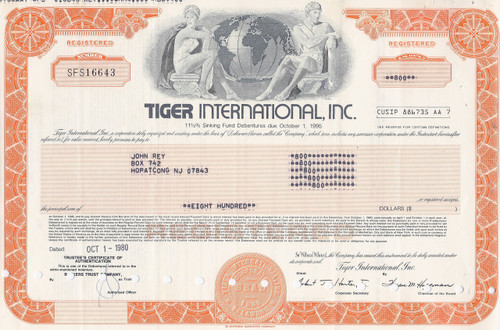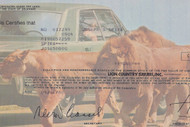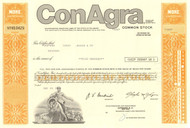Categories
Categories
Tiger international , Inc. 1980
Product Description
Flying Tiger International,Inc bond certificate 1980
This stock-sized bond features two Greek allegorical figures flanking a globe as the vignette. Registered bond dated October 1, 1980. Great Fedex and aviation collectible.
Flying Tiger Line, also known as Flying Tigers, was the first scheduled cargo airline in the United States and a major military charter operator during the Cold War era for both cargo and personnel (the latter with leased aircraft). The airline was bought by Federal Express in 1988.
The company was started by Robert William Prescott. It was headquartered on the grounds of Los Angeles International Airport in Westchester, Los Angeles, California. The airline was named after the Flying Tigers fighter unit of World War II, officially the 1st American Volunteer Group. Ten former AVG pilots formed the Flying Tiger Line (originally called National Skyway Freight) after returning to the United States in 1945. The pilots and two ground crew provided half of the initial investment, with the balance coming from California oil tycoon Samuel B. Mosher. For the next four years, Flying Tiger Line carried air freight on contract throughout the U.S. and, as the airline expanded, carrying supplies to U.S. troops under Gen. Douglas MacArthur during the occupation of Japan.
In 1949, the Civil Aeronautics Board awarded Flying Tiger Line the first commercial air cargo route in the U.S., a transcontinental route from Los Angeles and San Francisco, California to Boston, Massachusetts. Shortly afterward, the company began chartering passenger aircraft for group travel as well; its Lockheed Super Constellation, Douglas DC-4 and DC-6 fleet comprised the largest trans-Atlantic charter operation through the 1950s.
During the Korean War, Flying Tiger aircraft were chartered to transport troops and supplies from the United States to Asia; Flying Tigers later received a cargo route award to Japan, China, and Southeast Asia. The airline also played a major role in the construction of the Distant Early Warning Line, flying equipment to remote outposts in northern Canada and Alaska.
In 1974, the airline took delivery of its first Boeing 747. The Flying Tiger Line then put in orders for brand new Boeing 747-200F freighters designated the Boeing 747-249F, which at the time were among the heaviest commercial airplanes flying, weighing in at 823,000 pounds. These aircraft could carry 250,000 pounds of cargo loaded through both the nose door and the side door at the same time.
Tiger's Ad Hoc Charter livestock flights provided airlift for exotic animals. Two examples were thoroughbred racehorses and show animals from Stansted, England to the Melbourne Cup, as well as breeding stock cattle to nations such as Japan and Thailand. They became known for carrying a number of unique cargoes, including Shamu the SeaWorld killer whale and the torch of the Statue of Liberty.
By the mid-1980s, Flying Tigers operated scheduled cargo service to six continents and served 58 countries. It surpassed Pan American World Airways in 1980 as the world's largest air cargo carrier after acquiring its rival cargo airline Seaboard World Airlines in 1980. Covert flights for the military were not uncommon throughout the airline's history, given its roots in Civil Air Transport (CAT), as with its sister airline Air America, originally owned by General Claire Lee Chennault, commander of the Flying Tigers fighter squadron in Southeast Asia.
After airline deregulation, stiff competition buffeted profits and, with some unsuccessful diversification attempts by parent Tiger International, the airline began sustaining losses in 1981.[4] Then-CEO Stephen Wolf sold Flying Tigers to Federal Express in December 1988. On August 7, 1989 Federal Express merged Flying Tigers into its operations, and the Flying Tigers name passed into history.
 Loading... Please wait...
Loading... Please wait... 








